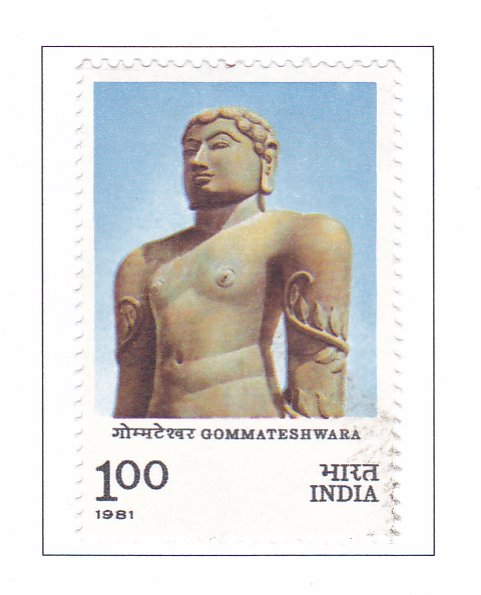Millennium of Gommateshwara (Statue at Shravanbelgola)

Technical Data
| Date of Issue | February 8, 1981 |
|---|---|
| Denomination | Rs. 1 |
| Quantity | 2,500,000 |
| Perforation | comb 14 x 14½ |
| Printer | Security Printing Press, Nashik |
| Watermark | No Watermark |
| Colors | Multicolor |
| Catalog Codes |
Michel IN 859 Stamp Number IN 892 Yvert et Tellier IN 657 Stanley Gibbons IN 999 |
| Themes | Anniversaries and Jubilees | Gods and goddesses | Statues |
According to Jain mythology, the first Tirthankara, Rishabhanatha, had two sons, Bharat and Bahubali. The two stepbrothers contested for supremacy, leading their mighty armies against each other in an impending battle. On the counsel of their ministers, they decided to settle the issue through a series of personal combats. Bahubali vanquished his rival but was disgusted by the debasement of human nature through greed, lust for power, pride, and violence. Consequently, he renounced the world and practiced severe penance in the Kayotsarga mudra (the posture of renouncing the physical existence) for a whole year.
Bahubali is known in South India as Gommateshwara. A colossal, monolithic statue of Gommateshwara was sculpted by Chamunda Raya, a minister and commander-in-chief of the Ganga King Rajamalla Satyavakya (also known as Rachamallar). This statue stands atop a granite hill at Shravanabelgola in Karnataka. The place derived its name from the pond of translucent waters (now known as Kalyani) around which Jain shramanas (ascetics) meditated.
The 18-meter-high colossus dominates the landscape from the 140-meter-high hillock. In the traditional Kayotsarga manner, his long hands reach his knees, a sign of a mahapurush (great man), and rest at his sides where Madhavi creepers entwine. The figure is imbued with human warmth and divine grace, as is traditional in Indian art. His face radiates inner bliss, reflecting the fulfillment a yogi achieves after a dedicated life. Oblivious to the world around him, his eyes are fixed at a point where cosmic ideas merge with our world of experience.
The anonymous master-sculptor who conceived the statue integrated two different modes of sculpture: the upper portion is carved fully in the round, while the lower one is in high relief. The richness of fine gloss through burnishing is comparable to the polished Asokan figures of the 3rd Century B.C. The statue was dedicated around 981 A.D. when the pratishthapana (holy installation) took place. To celebrate the thousand-year anniversary of the installation of the colossus, a mahamastakabhisheka (holy anointing) was performed in 1981. The Indian Post & Telegraphs Department is privileged to commemorate this occasion by issuing a special stamp.
(The above text is based on material published elsewhere and/or supplied by the sponsors.)
